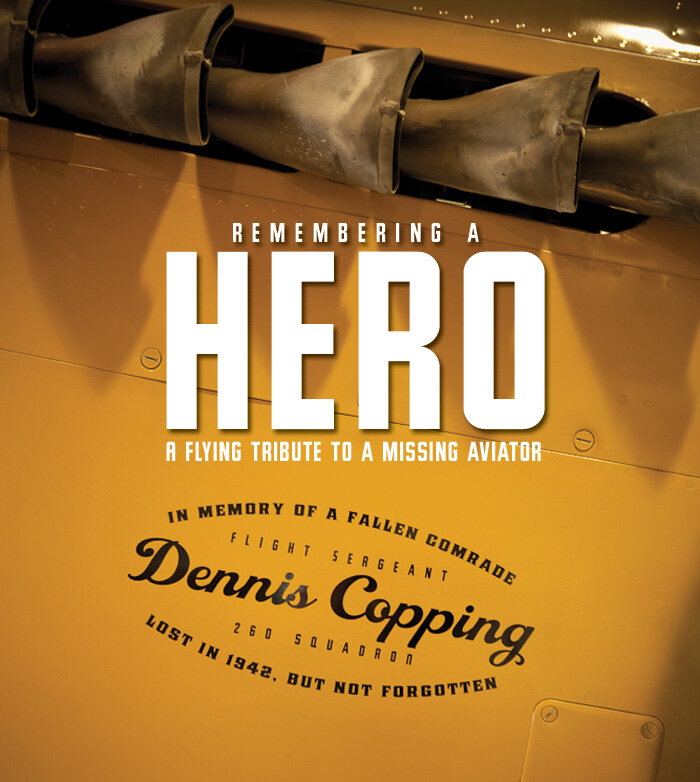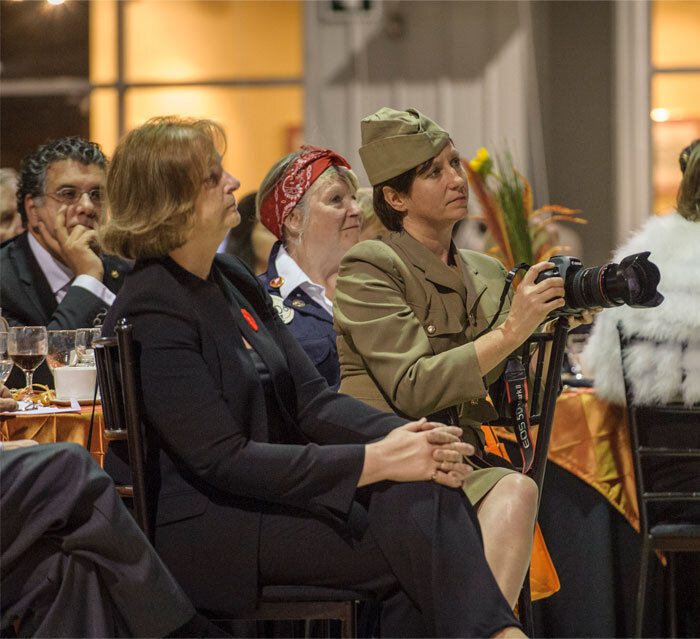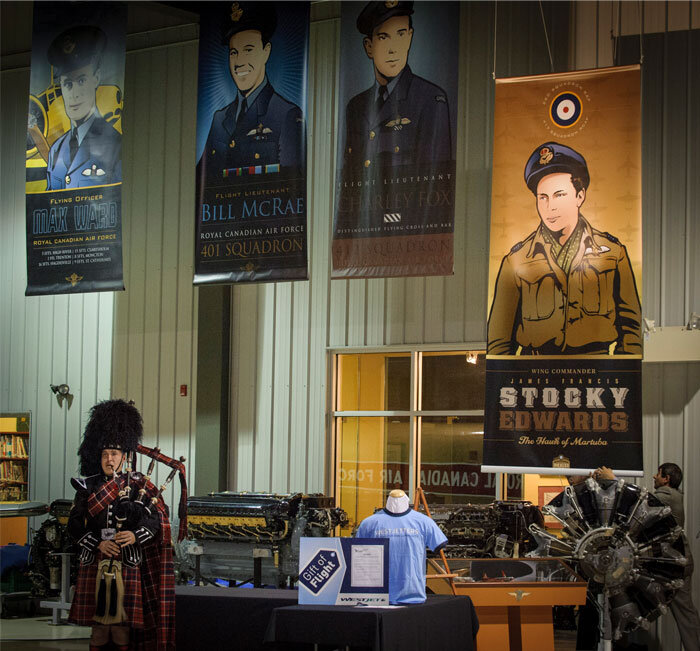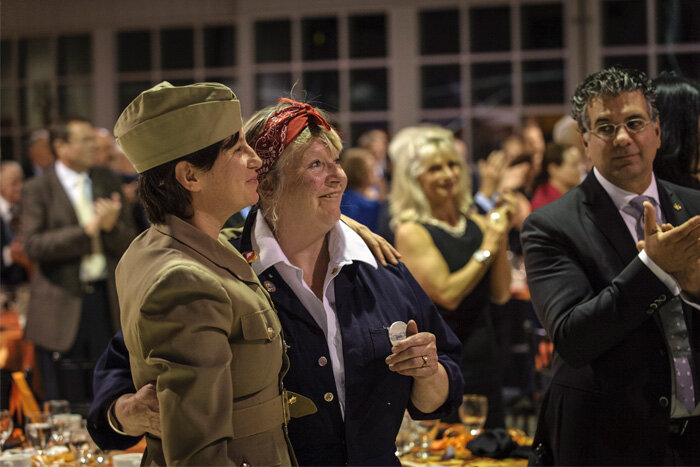PORTRAIT OF A LEADER
At the start of November, Vintage Wings of Canada hosted the Third Annual Members Gala. It was the best yet, and Carolyn Leslie and her crew are to be commended for an exceptional soirée enjoyed by all 150 guests in attendance. As is our tradition, the climax of the evening's festivities and formalities is the raising of a commemorative banner to honour one of Canada's great aviators of the Second World War. The honour is always a surprise for the honoured guest attending.
The tradition began after the memorial service for 412 Squadron legend and Honorary Colonel, Charlie Fox. Vintage Wings of Canada designed and raised a banner at the service honouring the famous Spitfire fighter pilot. After the service, we thought: “Why are we raising a banner to these great men after they die? Why not create one and raise it to the rafters when they are alive?” The following November, we chose our own volunteer, Bill McRae, himself a Spitfire fighter pilot with 401 Squadron RCAF, to be the first recipient of this honour and we decided to carry out the ceremony at our annual gala. Bill was deeply moved by the experience and we knew we were on to a good thing. Sadly, Bill died two months later, but he went knowing he was loved and appreciated for his sacrifice in the Second World War.
Last year, we honoured Canadian airline legend Max Ward, not for his well-documented and highly-applauded airline career with Wardair, but for his selfless work training pilots with the British Commonwealth Air Training Plan. Again, Max was very much touched by the experience of having a commemorative banner piped to the ceiling by a bag piper playing the RCAF March Past. And not just any piper... Canada's finest, Piper Graham Batty!
This year, with a year-long focus on the major aerial battles of North Africa, Malta and the Mediterranean, we selected the much-loved and much-storied Wing Commander James Francis Edwards, known by the nickname “Eddie” during the war and as “Stocky” after the war. Stocky was planning to attend, but with one week to go, he had to cancel his trip for a small medical operation. Luckily, his daughter Dorothy and his granddaughter Jesse were still able to attend.
We had hoped to hear a little bit about his history from Stocky himself, but now the honour of relating his remarkable story to the attendees would fall to Dave O'Malley, a volunteer at Vintage Wings of Canada. Here, in its entirety and for your enjoyment, is the speech Dave gave at our Gala honouring this legendary Canadian fighter pilot, ace, leader and hero.
The four banners of the Vintage Wings pantheon of great Canadian aviators. One day we hope to circle the walls of our hangar with these men... and women too. Banners by Dave O'Malley
Lieutenant General Yvan Blondin, the top commander of the Royal Canadian Air Force (Chief of the Air Staff (CAS)), himself a highly experienced fighter pilot and squadron leader, connects the audience with the story of Wing Commander James Francis Edwards. Photo: Peter Handley
Stocky's Story, as related by Dave O'Malley, follows:
As you know, Stocky cannot be here tonight in person, but we have his daughters Dorothy and Jesse here standing in for him. The honour has come to me to tell you a little bit of the astounding career of one of our most beloved leaders.
While reading Royal Canadian Air Force history and researching material for stories for our website’s Vintage News service, I come across many powerful, emotional and telling images of our air force in action during the Second World War. The ones that really reach out and take you by the heart are those images of young men whose lives are about to change for evermore. The faces from their training days are fresh and young, beaming with accomplishment, and flushed with exuberance. The faces we see later in the war, in theatre, in combat, are etched with strain and tension, cut by stress and lack of sleep. They still smile, laugh even, but there is a weariness that floods their countenance.
There is one photograph however that strikes a different chord every time I come across it. It is a simple, quiet portrait of a young man somewhere in Italy in 1943. It is the look on his face that makes me stare at the photo each and every time I look upon it.
The man in this photograph has endured much in the past two years of his short life. He is a long, long way from his Canadian Prairie home. He has suffered deprivation for months on end, felt discomfort every minute of every day and faced menace from every direction. He has seen death first hand. He has also meted out death at his own hands. He has lost friends and left others behind. The end of his life stalks him every day. Young men, just like him, depend on his skill and nerve to keep them safe while he takes them to the very edge of hell.
Related Stories
Click on image
The now famous photograph of then Squadron Leader James Francis “Eddie” Edwards in Italy in 1943 with the Vintage Wings of Canada Warbirds of the Med theme graphic for this year. Photo: RCAF
Dave O'Malley was given the privilege of sharing an abbreviated history of this gifted leader. Having his photo up for all to ponder during his talk helped the audience better visualize Edwards' great capacity for leadership. Photo: Peter Handley
What is truly remarkable is that the young man’s countenance is one of calmness, peace and even bemusement. His face is not pinched with stress or lack of sleep. His shoulders are relaxed, his hands in the pockets of his khaki trousers. Fear or loss cannot be read in his eyes. His whole body is surrounded by an aura of self-awareness and determination. He gazes outward, placidly, eyes focused on the job ahead.
This is a portrait of a man who understands what he is meant to do – a man who is in the right place at the right time. It is a portrait of a leader. This is Squadron Leader James Francis Edwards, known then as Eddie, now always referred to as Stocky. He has been in constant battle for a year and a half. He has gone from Sergeant to Squadron leader, from greenhorn to respected commander, from prairie boy to legend. He is just 22 years old.
During the Second World War, the greatest Canadian leaders were discovered, not manufactured. They were not formed in the classrooms of RMC or Staff College, nor did they spring from Leadership and Management Development Courses. They came from the wheat fields, the factory floors, the accounting offices and the high schools of a nation rising up to defend others against a bully of global proportions. Over the six long and trying years of the Second World War, our greatest leaders rose from the ranks of airmen like fast growing oaks. Men with leadership abilities were recognized immediately and promoted rapidly. They were the naturals. Stocky Edwards was one of the greatest of these natural born leaders, and it took a great threat to the world for him to be born.
Though Stocky could not make the cross-Canada trip from Comox, British Columbia, his daughter, Dorothy (dressed as Rosie the Riveter) and his granddaughter Jesse (dressed as a WAC) were in attendance, making the evening especially poignant. Photo: Peter Handley
Stocky grew up in Battleford on the windswept Central Saskatchewan Prairie. He lived like any prairie-bred Canadian boy – on hard work, hunting and hockey. Hardship was the norm in Saskatchewan during the Great Depression and the Dust Bowl. Complaint was a waste of time. Moving on was a way of life.
When war broke out, Edwards, a boy who had never even been close to an airplane, joined the Royal Canadian Air Force. He did his Elementary Flying Training at No. 11 EFTS in Edmonton and came home to Yorkton, Saskatchewan, for his Service Flying Training on Harvards. Like many before and after him, he journeyed by train and then by ship to England and joined an Operation Training Unit flying Hurricanes.
From there he was shipped to Takoradi, Ghana and quickly into the breech in battle in North Africa. He had not much more than 200 hours in his logbook and absolutely no training in combat flying or leadership.
He was assigned to 94 Squadron in Libya on Hurricanes and then Kittyhawks with 260 Squadron. On his very first combat sortie, a raid on an enemy airfield called Martuba, Stocky claimed his first victory – over a Messerschmitt 109, considered a much more capable aircraft. Time and time again, over the next year and a half, Edwards would prove that a less capable aircraft in the hands of a skilled pilot and marksman could triumph over a better machine flown by a lesser man.
I won’t take you through every victory of Stocky’s stunning combat record, for that would take all night, but I would like to speak in general terms about the distant and often forgotten theatre in which he would play a leading role.
The area of North Africa in which this monumental struggle took place – from Tunisia to the Suez Canal, was roughly the size of British Columbia, Alberta, Saskatchewan and Manitoba combined. The great land battles sweeping back and forth across this vast empty landscape were supported by the RAF’s Desert Air Force, whose job it was to interdict supply routes, both land and sea, and to support the fighters on the ground.
Not to diminish the difficulties and dangers of flying on operations over Europe, but the North African campaign took your basic life threatening mortal danger and added deprivation and loneliness into the mix. Pilots and aircrews could not troop off to the local pub to lift a pint and their spirits after a day of battle stress. There were no attractive local girls to woo. There were no weekend leaves to visit Piccadilly.
There were only meagre supplies of water and bully beef, and an abundance of sand and sweat and flies. By day, the heat was unbearable, after dark you could not keep warm. Constantly on the go, the RAF squadrons fought and moved, fought and moved, back and forth across a landscape that offered no landmarks or navigational hints. As difficult as life was in the brutal desert, Stocky would say: “I never thought much about being anywhere else. In fact I was having the time of my life. Little things didn’t matter; only the important things counted.”
Stocky’s part in this gargantuan struggle is legendary. Tested in combat, he rose up to meet the challenge rapidly. His leadership skills, natural ability to spot the enemy first, to make the right decisions and find his way home again, made him a natural leader on operations. Soon, he was leading his flight and often his entire squadron into battle. Trouble was, Stocky was still a Sergeant. In the desert air war, leadership was not about rank, insignia or formality, it was only about capability and trust. Stocky was the most capable – everyone trusted him.
In December of 1942, a year after his arrival in Africa, Stocky was promoted three ranks at once to Flight Lieutenant and given official command of B Flight – not that it mattered much to Stocky and the struggle he was engaged in. He had been leading B Flight for months.
Stocky’s war would play out right across the North African desert, over places that have become legendary in the history of the RAF – El Daba, Tobruk, El Alamein, Fuka, Martuba, Cyrenaica. By the time Stocky would leave the desert in early 1943, he had amassed an incredible record – 15.5 kills, 6.5 probable kills, 13 damaged aircraft and more than 200 tanks and military vehicles destroyed. He flew more than 260 combat hours on 195 combat sorties. He led the entire squadron on 42 occasions and accounted for 20% of 260 Squadron’s entire output. He had been awarded a Distinguished Flying Cross (DFC) and a Distinguished Flying Medal (DFM).
After leaving the desert war in 1943, Stocky’s career continued on in the same manner. By March he was promoted to Squadron Leader and given command of 274 Squadron in the Italian campaign. He led his squadron on operations during and after the D-day landings in 1944 and, after a full tour of duty, was sent back to Canada for a rest, a bond tour and as an instructor on Anson trainers. Unhappy being unable to lead, it didn’t take him long to extract himself from training and get back to Europe.
On landing in Europe for the third time, he was promoted to Wing Commander and given command of the four Canadian fighter squadrons of 127 Wing RCAF – 421, 416, 403 and 433 Squadrons. He was only 23 years old.
When it was all said and done, James Francis Edwards had completed an astounding 373 combat sorties and shot down 19 enemy aircraft (of which 18 were enemy fighters), won two DFCs, and a DFM. He went on to a postwar career in the RCAF, flying everything from Lancasters and Canso Flying Boats to Vampires, CF-100s, and Sabres.
It was during his postwar career that his nickname changed from Eddie to Stocky. His name was based not on his physique, which was anything but stocky, but on his steadfast nature. He refused to let anyone or anything get the better of him, and he played by the rules he was given.
As we go forward into next year’s flying season and indeed our entire future, our focus will be on our young people and passing on to them the lessons taught to us by men like Stocky Edwards – lessons of duty, honour and sacrifice. While Stocky is a legend, his lessons are real and immediate and powerful. His name is still spoken with reverence and respect. At 92 years, he leads us still.
Jesse, Dorothy, we want to honour your father’s entire career and in particular his service in the great and largely unknown aerial battles of the Mediterranean Sea. If this were the NHL we would retire his number and raise his jersey to the rafters of our arena. Consider this our equivalent.
Piper Batty, the RCAF March Past please.
As Piper Graham Batty, Canada's finest, plays the Royal Canadian Air Force March Past, a banner honouring Wing Commander James Francis Edwards is hauled to the rafters at Vintage Wings of Canada's hangar, to join the growing pantheon of our great military aviators – men like Max Ward, Bill McRae and Charlie Fox. Photo: Peter Handley
As the banner travels to the ceiling, Jesse and her mother Dorothy look on with pride and some emotion – it was a beautiful moment. Photo: Peter Handley
After the tribute to their father, Dorothy and Jesse pose with two of Canada's outstanding leaders of today – Vintage Wings of Canada's founder, Michael Potter and Chief of the Air Staff, Lieutenant General Yvan Blondin.













